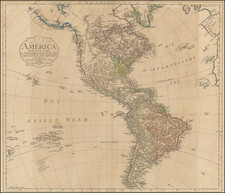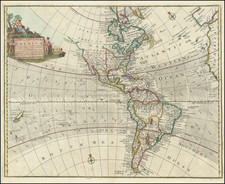1745 state of this finely engraved map of America, published by Guillaume De L'Isle in Paris.
De L'Isle's map of America was compiled from the best available source and includes significant modern cartographic detail for the period.
California is shown as a peninsula, having been corrected by De L'Isle as early as 1700, based upon his knowledge of Fra Eusabio Kino's reports. No Northwest Coast of America is yet shown, as De L'Isle's map would not include such detail until after the plate was inherited by Philippe Buache and reworked in 1763.
The Great Lakes and the course of the Mississippi River are quite accurate for the time period, with an early appearance of the name Texas (Tecas) , which first appeared on a map in 1718.
Guillaume De L'Isle (1675-1726) is probably the greatest figure in French cartography. Having learned geography from his father Claude, by the age of eight or nine he could draw maps to demonstrate ancient history. He studied mathematics and astronomy under Cassini, from whom he received a superb grounding in scientific cartography—the hallmark of his work. His first atlas was published in ca. 1700. In 1702 he was elected a member of the Academie Royale des Sciences and in 1718 he became Premier Geographe du Roi.
De L'Isle's work was important as marking a transition from the maps of the Dutch school, which were highly decorative and artistically-orientated, to a more scientific approach. He reduced the importance given to the decorative elements in maps, and emphasized the scientific base on which they were constructed. His maps of the newly explored parts of the world reflect the most up-to-date information available and did not contain fanciful detail in the absence of solid information. It can be fairly said that he was truly the father of the modern school of cartography at the commercial level.
De L’Isle also played a prominent part in the recalculation of latitude and longitude, based on the most recent celestial observations. His major contribution was in collating and incorporating this latitudinal and longitudinal information in his maps, setting a new standard of accuracy, quickly followed by many of his contemporaries. Guillaume De L’Isle’s work was widely copied by other mapmakers of the period, including Chatelain, Covens & Mortier, and Albrizzi.
Philippe Buache (1700-1773) was one of the most famous French geographers of the eighteenth century. Buache was married to the daughter of the eminent Guillaume Delisle and worked with his father-in-law, carrying on the business after Guillaume died. Buache gained the title geographe du roi in 1729 and was elected to the Academie des Sciences in the same year. Buache was a pioneering theoretical geographer, especially as regards contour lines and watersheds. He is best known for his works such as Considérations géographiques et physiques sur les découvertes nouvelles dans la grande mer (Paris, 1754).










![A Geographical Chart: or, A Scheme, Comprehending The Most Important Particulars Relative To The Geography of North and South-America. : Designed to be an Auxiliary to the Student. Carefully Compiled from the Best authorities, by Amos Bingham [Copy-Right Secured]](https://storage.googleapis.com/raremaps/img/small/41406.jpg)
![[Western Hemisphere]](https://storage.googleapis.com/raremaps/img/small/70708rd.jpg)

![[Globe with California as an Island on Allegorical Jesuit Engraving] Saeculum Nostrum in Illuminatione Vultus Tui Psal 89](https://storage.googleapis.com/raremaps/img/small/93732.jpg)
